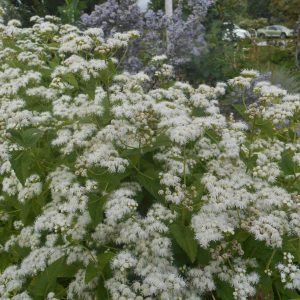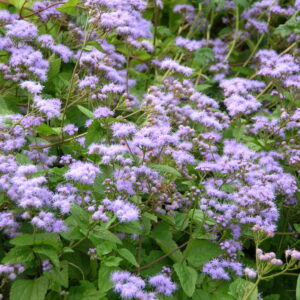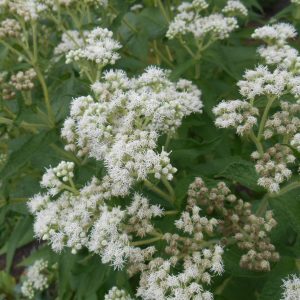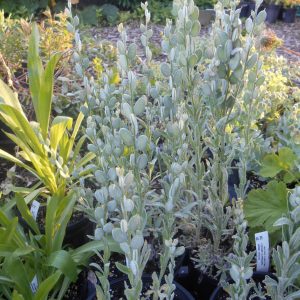Plants for Butterflies and Other Pollinators
Showing 81–88 of 211 results
-
Eryngium yuccifolium Rattlesnake master Z 3-8
Blooms July-October, prickly round white umbels. Leaves like thinner versions of a Yucca
Blooms July-October, prickly round white umbels. Leaves like thinner versions of a Yucca
Size: 48” x 18”
Care: Full sun, moist well-drained soil, Heat and drought tolerant
Native: Eastern United States, Wisconsin native
Wildlife Value: attracts many kinds of insects including bees, wasps, flies, butterflies, skippers, moths, and beetles for nectar and for pollen. Deer resistant.
Awards: Missouri Botanic Garden Plant of Merit.Eryngium is Greek meaning “thistle.” The name “Rattlesnake master” comes from the use by Chickasaw shamans of chewing the root, blowing it on the hands and then picking up rattlers without injury or “from its virtues of curing the bite of that venomous reptile.” Gardeners’ Dictionary, 1768. Valued by American Indians for medicinal uses: a diuretic, stimulant, and cure for venereal disease and impotence, purify blood; Chippewa for joint inflammation and strengthen young children and Cherokee as a toothache remedy; Sioux: Root cured bladder ailments, and rattlesnake bites and scorpion stings. A concentration of boiled root increased virility of Sioux men. The Forest Potawatomi used Rattlesnake master as a good luck charm – the top placed in a pocket made the gambler sure to win. 1st collected in Virginia by Rev. John Banister who moved to colonial Virginia in 1678. A gunman mistakenly shot and killed him while he collected plants.
-
Erythyranthe lewisii syn. Mimulus lewisii Lewis’ Monkeyflower Z 5-9
Bright rose trumpets with hairy yellow throats, flowers all summer
Bright rose trumpets with hairy yellow throats, flowers summer
Size: 2-3’ x 12"
Care: sun to part shade in moist to moist well-drained soil
Native: Alaska to California and as far east as Colorado
Wildlife Value: Nectar for hummingbirds and bees
Awards: Royal Horticultural Society Award of MeritFirst collected by Meriwether Lewis on the Lewis & Clark Expedition “on the head springs of the Missouri, at the foot of Portage hill,” in August 1805.
-
Eupatorium coelestinum album syn Conoclinium coelestinum ‘Album’ Mistflower ‘Album’ Z 3-7
Clusters of white in fall –close looks like a mophead of many strings, at a distance it looks like a big Ageratum - August to October.
Clusters of white in fall –close looks like a mophead of many strings, at a distance it looks like a big Ageratum – August to October.
Size: 3’ x 2-3’
Care: sun in moist to moist well-drained soil
Native: New Jersey west to Illinois south to Texas and east to Florida
Wildlife Value: attracts bees & butterflies - nectar source for American painted lady butterflyEupatorium named after Mithridates Eupator, ancient king of Pontus, Greece, said by Pliny to have used another species of Eupatorium medicinally in 1st century B.C. ‘Album’ first described and named in 1940.
-
Eupatorium coelestinum syn. Conoclinium coelestinum, Coelestina ageratoides Blue mist Z 3-7
Clusters of cornflower blue in fall –close looks like a mophead of many strings, at a distance it looks like a big Ageratum - August to October.
Clusters of cornflower blue in fall –close looks like a mophead of many strings, at a distance it looks like a big Ageratum – August to October.
Size: 3' x 2-3'
Care: full sun in moist to moist well-drained soil.
Native: New Jersey west to Illinois south to Texas and east to Florida
Wildlife Value: nectar source for many butterflies and both nectar and pollen for many beesEupatorium named after Mithridates Eupator, ancient king of Pontus, Greece, said by Pliny to have used another species of Eupatorium medicinally in 1st century B.C. This species 1st collected by Quaker planthunter and nursery owner John Bartram (1699-1777) in 1732 and offered for sale in Bartram Garden’s 1783 Broadside, America’s 1st plant catalog.
-
Eupatorium perfoliatum Boneset, Thoroughwort Z 4-8
Frilly white clusters atop 3’ tall stems brighten the garden July to September
Frilly white clusters atop 3’ tall stems brighten the garden July to September
Size: 4’ x 2-3’
Care: sun to part shade in moist to moist well-drained soil
Native: Maine to Florida west to Texas and north to Dakotas, Wisconsin native
Wildlife Value: Host for caterpillars of Lost Meadowlark butterflies. Nectar and/or pollen for numerous bees, butterflies, and wasps. Resistant to deer and rabbits.Named “boneset” because it was used to treat breakbone fever in 1800’s. Winnebago steeped it in a tea to cause sweating and stop fever. Sent to England in 1699. Grown in America’s 1st botanic garden Elgin botanic Garden in 1811.
-
Eupatorium purpureum syn. Eutrochium purpureum Sweet Joe Pye weed Z 4-9
July – September the top of each stem branches into several smaller stems. In turn a bundle of tubes grows out of each of these smaller stems and in turn more, thinner flowers grow out of each tube, forming a dusty rose dome a foot or more across.
July – September the top of each stem branches into several smaller stems. In turn a bundle of tubes grows out of each of these smaller stems and in turn more, thinner flowers grow out of each tube, forming a dusty rose dome a foot or more across.
Size: 5- 7’ x 3-4’
Care: Sun to part shade in moist, alkaline soil
Native: Eastern U.S., Wisconsin native
Wildlife Value: attracts bees and butterflies Monarch. Foliage feeds moth caterpillars.Named “Joe Pye weed” after an Indian medicine man who used the plant in New England to cure typhus. Meskwaki Indian men “nibbled (Joe Pye weed) when speaking to women when they are in the wooing mood.” This had the power of “fetching” women. Good luck when gambling for the Potawatomi. Oneidas used it to cure fever. Mahuna Indians of So. California made an infusion of the root to cure colds and coughs. Colonists used the plant to cure dropsy, gravel, gout, and rheumatism. Collected by Rev. John Banister who moved to colonial Virginia in 1678. A gunman mistakenly shot and killed him while he collected plants. Offered for sale in Bartram Garden’s 1783 Broadside, America’s 1st plant catalog.
-
Eupatorium sessilifolium Upland boneset Z 4-8b
Showy, flat to dome-topped, platter-like, numerous small-flower clusters of white bloom July to September
Showy, flat to dome-topped, platter-like, numerous small-flower clusters of white bloom July to September
Size: 3-5’ x 12-24”
Care: Shade to part shade in moist well-drained to dry soil (one of few dry shade flowers)
Native: Maine to Minnesota south to Kansas, east to Georgia. Wisconsin native (endangered, threatened or of special concern in 8 states – Indiana, Iowa, Maine, Michigan, Minnesota, New Hampshire, Vermont & Wisconsin
Wildlife Value: nectar attracts bees and butterflies. Foliage is food for their caterpillars. Deer & rabbit resistant.English botanist Rev. John Bannister (1654-1692) collected this in colonial Virginia. He was shot and killed by misadventure while collecting plants. Described by Scottish botanist Robert Morison (1620-1683) in Historis Plantarum Univeralis Oxoniensis pars tertia (vol. 3) 98, published posthumously in 1699.
-
Fibigia clypeata Roman shields Z 5-8
Yellow spring flowers in early summer, followed by small, oval “silver dollars” on erect stems. “What is that?” many customers ask.
Yellow spring flowers in early summer, followed by small, oval “silver dollars” on erect stems. “What is that?” many customers ask.
Size: 18” x 12-15”
Care: sun well-drained soil Self-seeds freely
Native: Southern Europe
Wildlife Value: source of nectar and pollen for bees and other insectsUsed for their ornamental seed pods. Harvest either when 1st form for fuzzy grey-green color or when mature with outer skin removed for translucent, silver shield. In gardens before 1753.








